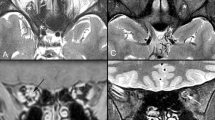Abstract
Introduction
Over the years, patients presented with cerebrofacial vascular malformations which occurred in clusters. The syndromic presentation suggested angio-architectural abnormality, which started to develop during embryogenesis. The segmentation of the neural tube could provide a rational explanation for such a neuropatholgical phenomenon. Based on this theory, cerebrofacial arteriovenous metameric syndrome (CAMS) was derived. This describes clinical association between arteriovenous malformations of the face, retina, and brain. In this case’s presentation, the syndromic presentation of the patient provided further evidence to the theory.
Case report
The authors report a case of a male neonate presenting with heart failure at birth. He was found to have a left sigmoid dural arteriovenous fistula (dAVF), an upper lip arteriovenous malformation (AVM), and a capillary hemangioma over the nose. The neuropathological clustering of vascular lesions is suggestive of CAMS. The patient was successfully treated with endovascular treatment and showed normal development during our follow-up assessment.
Conclusion
With the evolving evidence for the embryo-developmental theory for the clustering of angio-pathological lesions, further study and development of pathophysiology should be continued in following this track of theory. The success of endovascular intervention has warranted a favorable treatment option.






Similar content being viewed by others
References
Lee AW, Chen CS, Gailloud P, Nyquist P (2007) Wyburn-Mason syndrome associated with thyroid arteriovenous malformation: a first case report. AJNR Am J Neuroradiol 28(6):1153–1154
DeCesare B, Omojola MF, Fogarty EF, Brown JC, Taylon C (2006) Spontaneous thrombosis of congenital cerebral arteriovenous malformation complicated by subdural collection: in utero detection with disappearance in infancy. Br J Radiol 79(946):e140–e144
Bonnet P, Dechaume J, Blanc E (1937) L’anevrisme cirsoide de la retine. (Anevrisme racemeux) Ses relations avev l’anevrysme cirsoide ducerveau. Le Journal Medical de Lyon 18:165–178
DeMeritt JS, Pile-Spellman J, Mast H et al (1995) Outcome analysis of preoperative embolization with N-butyl cyanoacrylate in cerebral arteriovenous malformations. AJNR Am J Neuroradiol 16:1801–1807
Ham H, Burrows PE, Flodmark O, Terbrugge K, Humphreys R (1994) Neonatal superficial cerebral arteriovenous malformations. Pediatr Neurosurg 20:126–136
Howington JU, Kerber CW, Hopkins LN (2005) Liquid embolic agents in the treatment of intracranial arteriovenous malformations. Neurosurg Clin N Am 16:355–363
Jafar JJ, Davis AJ, Berenstein A et al (1993) The effect of embolization with N-butyl cyanoacrylate prior to surgical resection of cerebral arteriovenous malformations. J Neurosurg 78:60–69
Kang HS, Han MH, Kwon BJ, Yoon BW, Chang KH (2005) Cerebellopontomandibular vascular malformation: a rare type of cerebrofacial arteriovenous metameric syndrome. Case report. J Neurosurg 102(1):156–160
Luessenhop AJ, Spence WT (1960) Artificial embolization of cerebral arteries: report of use in a case of arteriovenous malformation. JAMA 172:1153–1155
Mathis JM, Evans AJ, DeNardo AJ, Kennett K, Crandall JR, Jensen ME, Dion JE (1997) Hydrophilic coatings diminish adhesion of glue to catheter: an in vitro simulation of NBCA embolization. AJNR Am J Neuroradiol 18:1087–1091
Morgan MK, Johnston IH, De Silva M (1985) Treatment of ophthalmofacial-hypothalamic arteriovenous malformation (Bonnet–Dechaume–Blanc syndrome). Case report. J Neurosurg 63:794–796
O’Neill OR, Barnwell SL (1995) Catheter systems and endovascular hardware. In: Maciunas RJ (ed) Endovascular neurological intervention. American Association of Neurological Surgeons, Park Ridge, IL, pp 43–58
Lasjaunias P, ter Brugge KG, Berenstein A (2006) Cerebrofacial arteriovenous metameric syndrome In: Surgical Neuroangiography, 2nd edn. Springer Berlin Heidelberg, New York, pp 359–388
Reck SD, Zacks DN, Eibschitz-Tsimhoni M (2005) Retinal and intracranial arteriovenous malformations: Wyburn-Mason syndrome. J Neuroophthalmol 25:205–208
Riina HA, Gobin YP (2001) Grading and surgical planning for intracranial arteriovenous malformations. Neurosurg Focus 11:e3
Sarnat HB, Flores-Sarnat L (2005) Embryology of the neural crest: its inductive role in the neurocutaneous syndromes. J Child Neurol 20:637–643
Serbinenko FA (1974) Balloon catheterization and occlusion of major cerebral vessels. J Neurosurg 41:125–145
Spetzler RF, Wilson CB, Weinstein P et al (1978) Normal perfusion pressure breakthrough theory. Clin Neurosurg 25:651–672
Venkat RC, Dixon MM, William RB (1995) Vascular malformations of the central nervous system. J Neuropathol Exp Neurol 54:609–621
Wong IYC, Batista LL, Alvarez H et al (2003) Craniofacial arteriovenous metameric syndrome (CAMS) 3—a transitional pattern between CAM 1 and 2 and spinal arteriovenous metameric syndrome. Neuroradiology 45:611–615
Wyburn-Maon R (1943) Arteriovenous aneurysm of midbrain and retina, facial naevi and mental changes. Brain 66:163–203
Yates AG, Paine CG (1930) Case of arteriovenous aneurysm within brain. Brain 53:38–46
Author information
Authors and Affiliations
Corresponding author
Rights and permissions
About this article
Cite this article
Bun, Y.Y., Ming, C.K., Ming, C.H. et al. Endovascular treatment of a neonate with dural arteriovenous fistula and other features suggestive of cerebrofacial arteriovenous metameric syndromes. Childs Nerv Syst 25, 383–387 (2009). https://doi.org/10.1007/s00381-008-0753-y
Received:
Published:
Issue Date:
DOI: https://doi.org/10.1007/s00381-008-0753-y




